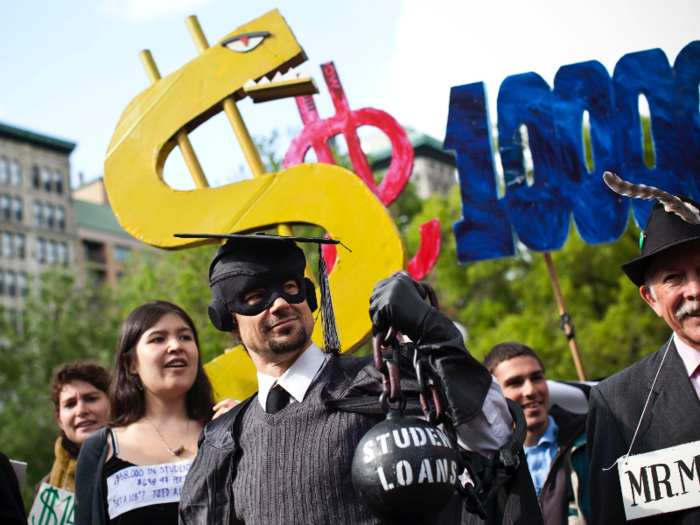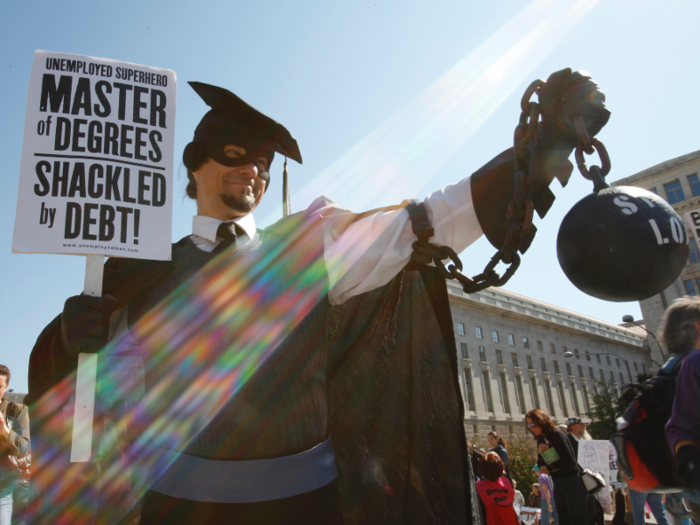- Home
- slideshows
- miscellaneous
- A 10-step plan to paying off student loan debt, from someone who repaid over $40,000
A 10-step plan to paying off student loan debt, from someone who repaid over $40,000
1. Know what you owe

2. Triage your student loan debt

If you are in danger of or already missing student loan payments, Kirkham advised that you try to triage them.
"First, switch federal student loans to an income-driven repayment plan to lower monthly payments," she said. "Then, apply for deferment or forbearance to pause payments if you hit a major financial setback, such as losing a job."
Many private student loan lenders also provide an option to defer payments, Kirkham said. "And keep in mind that unless you have Direct Subsidized Loans, deferred student debt will continue to accrue interest and your balance will increase."
3. Assess other financial considerations

Kirkham said to consider if other financial goals need attention before you can go gung-ho on student debt. "If you have other debt, like credit card balances, that are costing you more than your student loans are, it might be wise to pay these off first," she said.
4. Get — and keep — your living costs in check

Kirkham suggested that you keep your biggest monthly costs as low and affordable as you can.
"I got married right out of college, and my husband and I had borrowed over $40,000 to pay for our educations," she said. "We paid off my student loans right away — about $17,000 within three years of graduating — and we just paid off the remaining student loan balance in July 2018!"
She said that keeping her lifestyle in check was a huge factor that enabled her to pay off her student loans in a timely manner. “I chose more affordable apartments, for example, and shared a car with my husband for years to put off buying a second vehicle,” she said.
Kirkham said to take a look at your own monthly spending and rework your budget. “Outline recurring expenses, be critical, and see if there are any you can cut out or trim down,” she said. “For instance, can you keep just one of the three video streaming services you’re subscribing to? Each dollar you trim from your expenses means an extra dollar you can use to pay off student loan debt.”
5. Decide how much to put toward student loans

"Once you calculate your set expenses, look at how much is left over," Kirkham said. "This is your discretionary income — money that you are free to decide how and when to spend."
She says you should decide how much of your discretionary income you want to put toward making payments on your student loan debt. "It’s best to set a firm dollar amount that you can pay each month," she said.
Kirkham said that although you feasibly could afford to put all of this toward your student loans, it’s important to be realistic. "You want to create a spending plan you will actually stick to," she said. "Try to cut back on this optional spending without making yourself miserable. For example, I learned to DIY what I could: I cooked at home, worked out at home, and even learned to give myself a pretty great self-manicure."
6. Make extra student loan payments each month

Make additional student loan payments each month by setting up an automatic, extra payment to go through after each deposit, Kirkham said. "This puts your student debt goal first and keeps it on track, instead of putting it at the mercy of your spending habits."
However, she said to check your monthly statements to make sure your extra student loan payments are applied properly. "Some servicers will count them as advance payments instead of applying them to your principal, for example," she said.
7. Target high-interest student loans first with the debt avalanche method

You may be familiar with the debt avalanche method of paying off credit cards, in which you pay off the highest-interest card first. Well, the same goes for student loans.
"As you pay down this balance, this will also lower the amount of interest you're being charged each month, so your dollars are used to actually lower your principal and get you out of debt," Kirkham said. "If you pay off this first loan, you simply put the amount you were paying (including both the monthly payment and extra payments) toward the student loan with the next-highest interest rate."
8. Refinance certain student loans

Another way to target high-interest student loans could be to refinance them, Kirkham said.
"Private student loans and PLUS student loans, in particular, tend to have high enough interest rates that it could make sense to refinance," she said. "You'll need to be well-qualified, but taking this step could help you replace your high-interest student debt with a new private student loan at a lower interest rate."
9. Put any windfalls or raises toward your student debt

Kirkham suggested looking for "extra" income that you can use to take a chunk out of your student loan balances, such as tax refunds, bonus pay, cash gifts, raises, and income from side hustles.
"In particular, focusing on growing your income through earning raises, trading up to a better job, or starting a side hustle can be great ways to generate more money you can use to target student debt," she said.
10. Pace yourself and stay motivated

"Paying off student loans is a marathon, not a sprint, and it requires similar skills and strategies," Kirkham said. She said to pace yourself and find a budget and student loan system that works best for you.
"Keep your eye on the prize and stay focused on your goal of paying off student loans," she said. "Track your progress and celebrate your wins as you go, from the first extra payment you make to the first student loan you pay off to the last payment you ever send a student loan servicer."
Popular Right Now
Popular Keywords
Advertisement